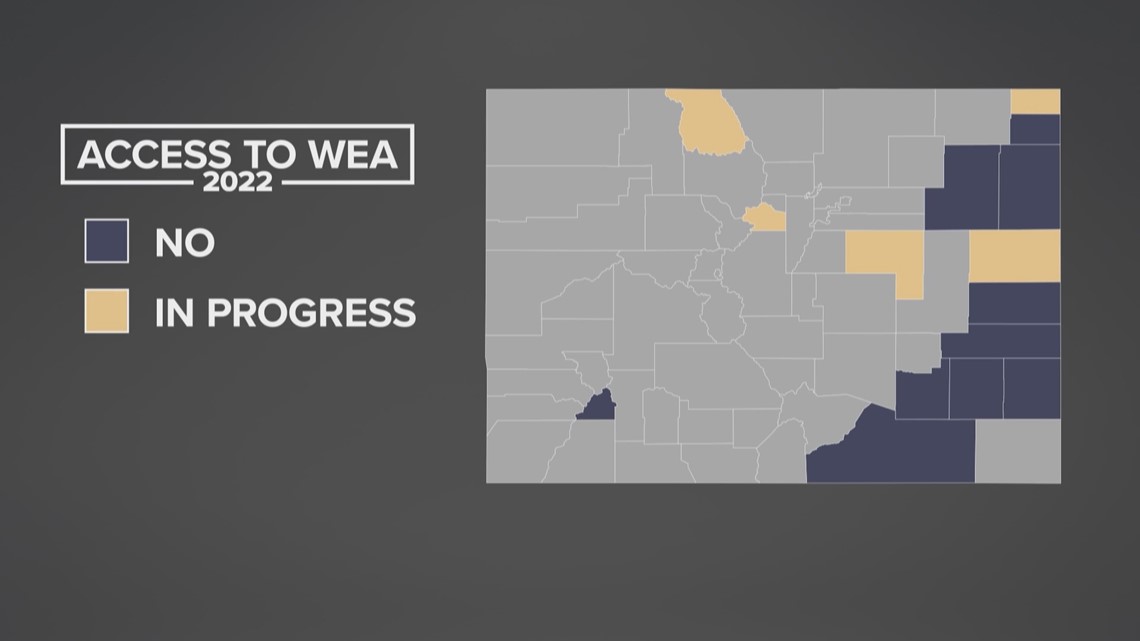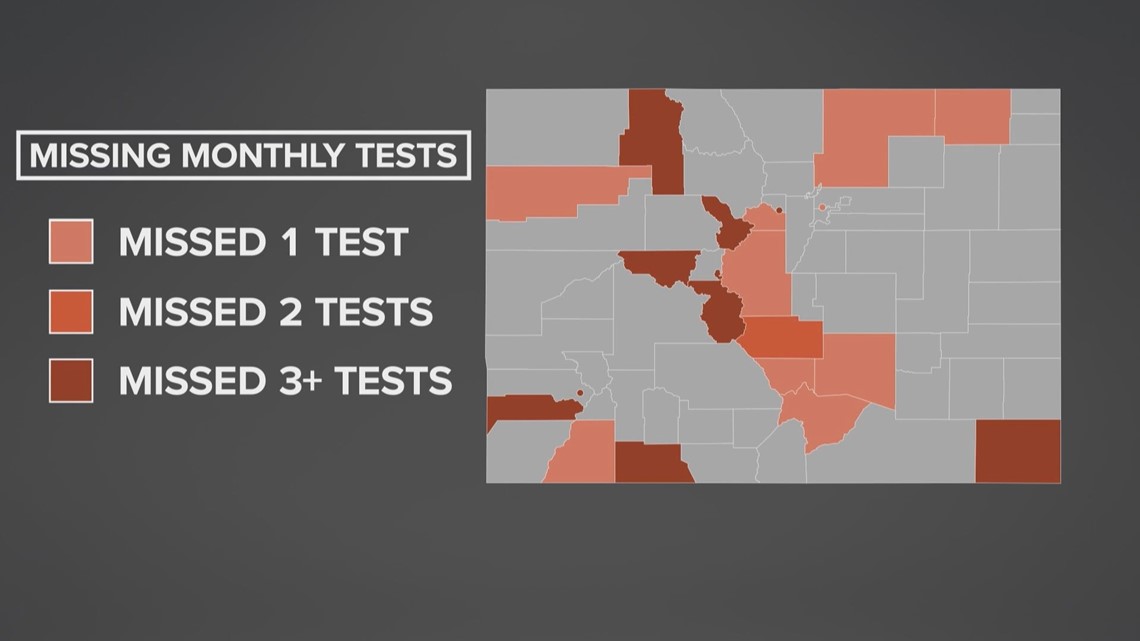COLORADO, USA — In the hours after a man ran over two parole officers in Colorado Springs, killing one, first responders initiated a statewide manhunt. But it was not just law enforcement carrying out the search.
Cell phones across the state went off at 6:17 p.m. on Sept. 28, with details on a crime that would soon turn deadly. A “Blue Alert” activation instructed Coloradans to look out for 41-year-old Justin Kula.
“Please do not approach vehicle or subject and call 911 if seen,” the alert read.
That message, sent through the federal Wireless Emergency Alert (WEA) system, paid off.
"As a result of the Blue Alert, many community members contacted the Colorado Springs Police Department reporting the location of the suspect vehicle,” Colorado Springs Police spokesperson Ira Cronin said the next day.
Parole officer Christine Guerin Sandoval died in the crash. Another officer was injured but survived. Kula is charged with vehicular homicide.
RELATED: What is a Blue Alert?
There are nearly a dozen counties in Colorado where first responders do not have the ability to reach cell phones with that kind of urgent information. In emergency situations like wildfire evacuations, life-threatening flooding, and shelter-in-place orders due to law enforcement activity, those counties must ask the state or a neighboring jurisdiction to send an alert to cell phones on their behalf.
The federal government calls WEA “an essential part of America’s emergency preparedness,” but Colorado will not meet its goal of getting every county in the state access to the system by the end of 2023.
The state is pushing the goal back to the end of 2024, but that new timeline may prove impossible. Even counties that do have access to the system are in danger of getting kicked off.
A difficult goal
The federal system allows first responders to send short messages to every cell phone in an area drawn on a map. Unlike subscription-based alert services like Everbridge or Smart911, WEA does not require residents to sign up to receive alerts to their phones, and messages are sent based on the phone's location, not whatever address happens to be on file.
Jurisdictions must complete a series of trainings and draw up an agreement with the Federal Emergency Management Agency in order to access the system and its television and radio counterpart, the Emergency Alert System.
In July 2022, 15 of Colorado’s 64 counties had not completed those steps, according to the state’s Division of Homeland Security and Emergency Management. Five counties were in progress but still unable to access the system.


“One of our goals is to make sure that we have 100% capability for communities in Colorado to send their own [WEAs],” DHSEM Director Kevin Klein told 9NEWS in 2022. “There are areas of the state that still need some help there, and it's one of our goals to make sure that they're capable of doing that.”
More than a year later, only four additional counties have come on board -- Clear Creek, Jackson, Elbert and Sedgwick. Kit Carson County remains in the process, still waiting to sign and submit its agreement with FEMA. Eleven other counties have not taken steps to initiate the process, according to the state.


“Frankly, some of these communities are small, and don't have full-time staff. So they rely on part-time staff for their emergency managers,” Klein said in October.
In the summer of 2022, Bent County Emergency Manager Troy Abdulla told 9NEWS he had a sticky note on his computer with “IPAWS” written on it - a reminder to work on FEMA training when he had a free moment. As the only person in his department, he rarely did. Bent County remains without WEA access.
Emergency managers in other counties told 9NEWS they didn’t view WEA as essential.
In Phillips County in northeast Colorado, which hasn’t applied to use IPAWS, Emergency Manager Broc Pelle said last year that 90% of residents opted-in to the county’s optional alert system, which he said works well.
“As a county, we are continuing to seek information in relation to IPAWS and will implement the system if it proves to be the best option,” Pelle wrote in an email.
If one of those counties without WEA access wishes to send an alert, the state can send one on the local jurisdiction’s behalf.
“We have other means of providing the same alerting for those communities that haven't got their own [agreements with FEMA],” Klein said.
The state made such an offer as the Marshall Fire burned homes in Boulder County on Dec. 30, 2021. The county had access to WEA but had not finished setting it up.
As two fires merged and burned down more than 1,000 homes throughout Louisville and Superior, the county relied on its opt-in alert system, Everbridge, to communicate evacuation orders. Only 24% of the county’s population had opted-in with a cell phone at the time.
The state offered to send a WEA about evacuations in addition to the messages that went to landlines and opted-in cell phones. The county declined because evacuations were already underway, Boulder Office of Disaster Management Director Mike Chard told 9NEWS in the weeks after the fire.
“The practice of integrating the state in active local evacuations had not been exercised or practiced in a real world incident with Boulder,” Chard wrote in an email to 9NEWS in January 2022. “During an evacuation it is important that the operational incident command and the 911 center or alerting center are tied together. It is important to have this tight connectivity to ensure information is correct, clarification opportunities can occur and coordination with field operations occurs as easily and quickly as possible. The state does not have this real time situational awareness, and suddenly creating a process to provide it was not possible.”
After-action reports on Everbridge during the Marshall Fire showed only one in five people who were sent alerts confirmed that they received them.
Warnings about severe weather including tornadoes, severe thunderstorms and some flash floods are sent by the National Weather Service, not local jurisdictions or the state.
Klein said the state’s new goal for WEA adoption, the end of 2024, may still be a challenge to accomplish.
“I think it's going to be difficult to hit that goal,” Klein said. “But I think more important is that we've got systems in place to make sure that [counties without WEA] get the coverage one way or the other.”
Testing failures
Colorado has a problem beyond those 11 hold-out counties. Even places that have the system may be in danger of losing it.
Nineteen of Colorado’s 54 agencies with WEA access have missed mandatory internal tests of the system in the last five months, according to FEMA data shared with 9NEWS by DHSEM.
FEMA requires jurisdictions with WEA, known as alerting authorities, to conduct monthly “proficiency demos” where they send a test message that does not go out to the public. If an alerting authority fails to send one test, FEMA sends a reminder. At two consecutive missed tests, FEMA notifies the alerting authority and its state oversight team. At three missed tests in a row, FEMA cuts off access to the system that sends WEAs and alerts over TV and radio, according to the agency’s website.
From June to September, nine communities in Colorado missed three tests in a row, according to the FEMA data.


DHSEM told 9NEWS no county has ever lost access to WEA, because the state has intervened before that could happen.
“We did have to go back and work with a couple of counties to make sure that they got the testing done,” Klein said. “They let us know when they fall behind and then we work with them to make sure they're doing it.”
Some counties, including Routt and Archuleta, missed three consecutive tests in August and also missed tests in September, with no indication in the FEMA data that they remedied their lack of testing.
Emergency managers in Archuleta County did not respond to questions about testing.
After this story was published, on Wednesday afternoon, Routt County's Emergency Operations Director told 9NEWS they resolved a testing issue Wednesday morning. The county missed tests due to staffing shortages and a focus on training new dispatchers, Director David DeMorat said. The county also had a problem with its training certificates, so even tests completed on the county's end did not appear for FEMA. They successfully sent a test Wednesday morning, DeMorat said.
“Oftentimes what we find out is somebody else has taken on the job and didn't know [the monthly test] was part of their responsibility,” Klein said. “We'll contact them and let them know ‘by the way, in addition to these other things, you need to do this monthly testing, please.’”
9NEWS reached out to every jurisdiction that failed multiple tests in the last five months.
In Baca County, which missed tests in July, August and September, Emergency Manager Jennifer Leathers told 9NEWS via email she thought she completed the exercises.
“That’s very interesting! I know that I did one in July. I may have done something wrong, we were trying to learn this system. I may have missed the next two,” Leathers wrote. “I know my certificates expired sometime during that time period. We worked on getting that all set back up through [our alert software] and I’m guessing that I did miss those two months. I have done [October’s], I hope it shows up on their end! It shows completed on mine!”
In Summit County, which had missed three consecutive tests by June and caught up on July 6, Director of Emergency Management Brian Bovaird told 9NEWS in an email, “The lapse in monthly proficiency testing was 100% on me, as I am responsible for conducting those monthly tests.”
“Those monthly tests are mostly to ensure that the technical components of the system are working properly and that our capability to initiate messages through the system is current,” Bovaird wrote. “What those monthly tests don’t accomplish is a comprehensive understanding of what public protective actions are available, when they should be used and the coordination between first responders in the field and 911 personnel.”
Black Hawk is one of the few cities in Colorado with its own WEA capabilities. When reached by phone, Black Hawk Police Department Commander Troy Cooper told 9NEWS tests had been overlooked from July through September during a remodeling of their dispatch center.
Cooper thanked 9NEWS for the reminder about the monthly test, as it was the last day of October, and said they would get back on track that day.
Offering support
The state recognizes the process to obtain WEA access and keep up with the system’s requirements can be a heavy lift for emergency managers stretched thin by limited staffing and increasingly intense climate-driven disasters.
“Anything that the state can do, knowing that you're probably short-staffed, to help these counties out to make sure that they have the [resources], we do,” Klein said.
The state offers grants to support emergency management departments, and training to improve alert and warning tactics, Klein said.
“It's not just Wireless Emergency Alerts. It's not just the Emergency Alert System. It is a combination of all those things that need to come together to get the word out,” Klein said. “We need to be better prepared to address an increase in the frequency and severity of disasters.”
SUGGESTED VIDEOS: 9NEWS Originals

